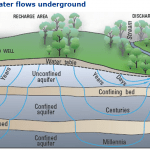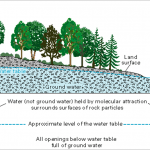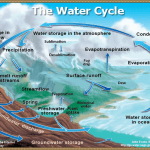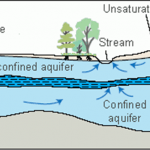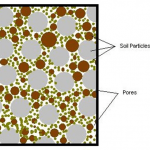A BRIEF OVERVIEW OF GROUNDWATER
Groundwater is part of the hydrologic cycle. Water on land has some basic flow paths: when it rains, the water either flows along the ground into rivers and lakes, evaporates into the atmosphere, or it percolates down into soils and rocks and eventually into a water-bearing layer, or aquifer.
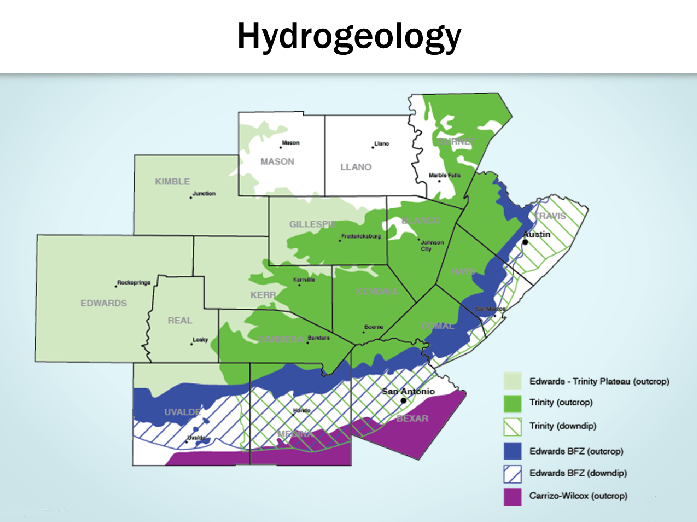
Knowing about these linkages is key to understanding that groundwater is a part of our rivers, our water supplies, avoiding land subsidence through over-pumping, and a host of other issues.
Groundwater is that portion of rainfall and surface flow that infiltrates into the ground. This subsurface water moves into the spaces between soil particles or in the fractures of rock layers. A sponge is a good comparison: the water moves into the sponge and fills the pore spaces. How quickly this movement occurs depends on the soil and/or rock material, depth from the surface, and related factors.
When talking about the spaces within the rocks and soil, geologists refer to two key terms: porosity and permeability. Porosity refers to the size of the spaces between soil particles. Air, smaller particles, organic materials, and liquids, such as water, can reside in these spaces.
Permeability is a measure of how connected the pore spaces are. In the diagram below, different materials (fractured rock to the bottom left and gravel to the bottom right) allow water to flow through at different rates and periods of time.
Whether the percolating groundwater completely fills the pore spaces determines whether the groundwater can be considered part of the unsaturated zone that contains both water and air in the pore spaces. If there is no air in the pores, the groundwater is in the saturated zone, often called the water table or unconfined aquifer. Confined aquifers are those under pressure due to overlying rock strata that has very tight pore space and allows little to no groundwater movement.
The length of time it takes for water to recharge, or move into, an aquifer system depends on the soil and rock characteristics and the rate of water. The rate of recharge can vary from days to centuries: day to recharge portions of an aquifer with very large, cave-like openings such as found in the Edwards Aquifer of Central Texas, and centuries to recharge a 4-state region with many layers of soil and rock such as the Ogallala Aquifer.
How much groundwater is stored under our feet? By one estimate, about 30% of global fresh water supplies, not including saline or brackish waters, is groundwater (Gleick, P.H., 1966: Water Resources. In Encyclopedia of Climate and Weather , ed.by S.H. Schneider, Oxford University Press, New York, vol. 2, pp. 817-823). Of all waters on earth, groundwater stores about 1.7% with 96.5% in the oceans (NASA website, 2011).
IMAGE GALLERY
Interested in learning more? Please check the following online materials for more information and different perspectives on understanding groundwater and aquifers:
US Geological Survey – explanations of the water cycle
Texas Water Development Board, Groundwater Resources Division, Groundwater 101 Presentations
Michigan Dept of Environmental Quality, “Water” module
The Groundwater Foundation
“We educate people and inspire action to ensure sustainable, clean groundwater for future generations.”
North Carolina Department of Environment and Natural Resources, Basic Hydrogeology

